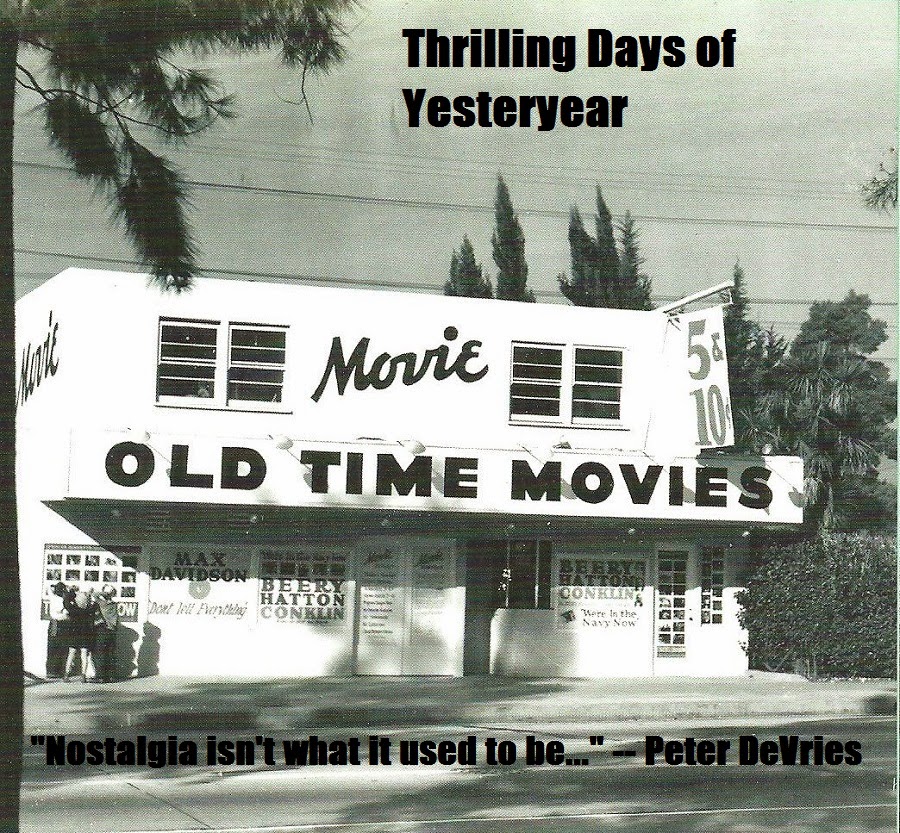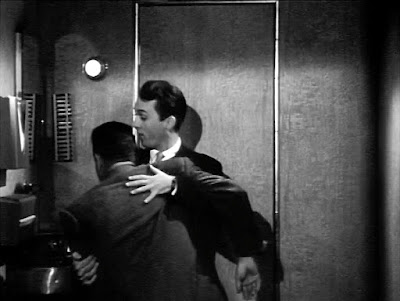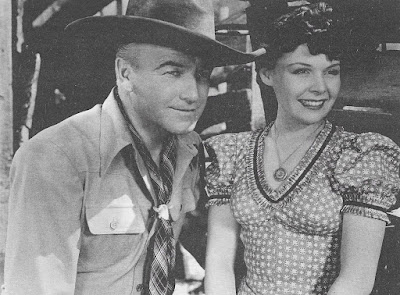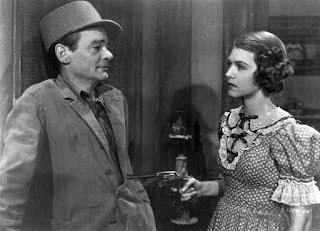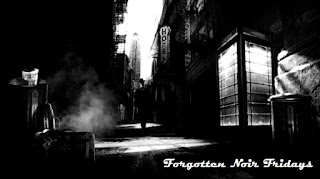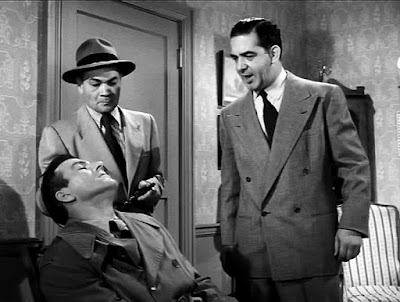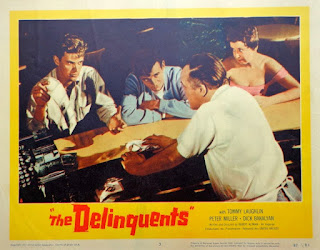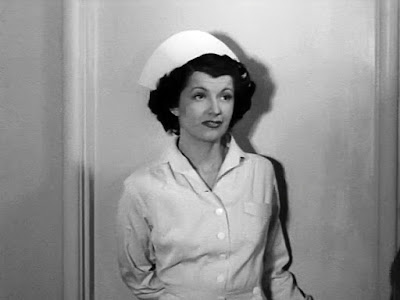My fellow classic movie mavens are well aware that in the
month of February (and first three days of March—except leap year), The
Greatest Cable Channel Known to Mankind™ runs their “31 Days of Oscar” tribute. This event and “Summer Under the Stars”
usually allows me to catch up with whatever I have squirreled away on our DISH
DVR, and I was very much looking forward to watching the content (and slapping
my favorites onto disc).
But…in the immortal words of Robert Frost: “The best laid schemes
o' mice an' men/Gang aft a-gley.” (Who says this blog isn’t highbrow? Besides 98% of the blogosphere, I mean.)
The good people at DISH decided to have a “freeview” weekend
of HBO, Cinemax, and Showtime the weekend of February 17-20. The following weekend, we were treated to
free Starz. The weekend after that, Encore. And we just finished up a freeview of Epix
this past weekend. For a recovering
movie nut like your humble narrator, this is an embarrassment of riches—particularly
because when there isn’t anything on the schedule worth grabbing, there’s
always On Demand offerings I can download.
I have been spending every free waking moment luxuriating in movies,
movies…and more movies.
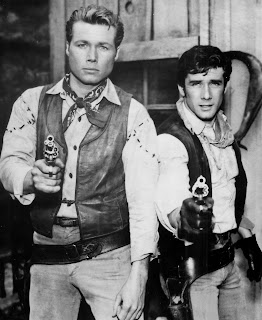 |
| Laramie stars John Smith and Robert Fuller |
It shouldn’t come as a surprise that I went hog wild during
the Encore freeview…because their On Demand features episodes of the classic TV
westerns they offer on their schedule—this is how I was able to build my
substantial
Wanted: Dead or Alive collection
back
in December of 2015. Encore Westerns on Demand has episodes of
Death
Valley Days,
Laramie,
The Life and Legend of Wyatt Earp,
Tales
of Wells Fargo (a recent acquisition), and
Wagon Train—which
presented me with a dilemma: which show do I download?
I eliminated Death Valley Days and Wagon
Train right off the bat; I like both shows—but they’re not something I have to have. I leaned heavily toward Laramie, particularly due
to the piss-poor quality of the Timeless Media Group DVDs…but I’ve got a 30-day
window with these downloads, and I didn’t think I could get all EW had in that
amount of time (particularly since they’re 50-minute shows). There’s DVR space to consider, too—I like to
have enough of a “buffer” in case Mom (who learned how to work the DVR during
her convalescence) wants to grab any Rambo
movies or something with Jean-Claude God Damme. (I don’t know why she insists on recording
stuff with commercials…particularly since she hasn’t learned to fast-forward
yet.) So, it came down to either Wyatt
Earp or Wells Fargo…and since all six seasons of Earp have been released
to disc, I went with Fargo (its DVD release history is a
little spotty).
Tales of Wells Fargo originally premiered as a December 14,
1956 episode of CBS’
Schlitz Playhouse of Stars,
“A Tale of Wells Fargo”—with a teleplay by Frank Gruber from a Zane Grey
story. The producer of this episode, Nat
Holt, had also produced the 1949 film that gave future
Wells Fargo star Dale
Robertson his first onscreen credit,
Fighting
Man of the Plains (
Fargo creator Frank Gruber also
wrote this screenplay…in addition to the novel on which it was based). Holt had quite a time talking Robertson into
doing “Tale” as a regular series—Dale initially didn’t think much of the
script, and only agreed to commit to the pilot as a favor to his friend. He never dreamed that the show would leap to
#3 in the Nielsens in its second season (
Tales of Wells Fargo officially
premiered over NBC on March 18, 1957). (
Wells
Fargo remained in the Top 10 in its third season, and continued to be a
solid ratings performer until its final season in 1961-62. More on this in a bit.)
I thought that by downloading all the
Wells Fargo Encore
Westerns had to offer, I could play a few for
mi madre—a longtime fan of the show. I know I mentioned this on the blog in the
past (my previous experience with
Wells Fargo was a single episode, “Jesse
James,” which was on Timeless’
The
Classic TV Western Collection) but my father used to tease my
mother unmercifully about this series, derisively referring to the star as “Dale
Roberts” and saying…well, I won’t repeat
exactly
what he said (it’s a little insensitive) but he hinted that Mr. Robertson was a
few horses shy of a remuda. I’ve watched
13 out of the 14 episodes in the first season (“The Silver Bullets” did not
download properly, much to my dismay) and a couple from Season Two…and I don’t
know why Dad kids Mom so. Granted, I do
not possess the sophisticated television tastes as my old man (and by “sophisticated
television tastes” I mean shows about UFOs and cops placing people under arrest)
but I’m finding
Tales of Wells Fargo to be a pretty entertaining series. It’s not a great show (there are superior
western half-hours, like
Gunsmoke and
Have Gun – Will Travel)
but it’s far and away better than
The Cisco Kid or any other juvie
oater you’d care to name. Robertson didn’t
consider
Wells Fargo an “adult western” or a “kids western”—but a “family
western,” assuming your family conducted private investigations for the Wells
Fargo company for a living. (That’s the
premise in a nutshell: as Jim Hardie, Robertson chased down bad hombres who
robbed the company’s stagecoaches or freight wagon in the 1860s/1870s/1880s, and
brought the miscreants to justice. This
was quite a few years before the Wells Fargo company started committing fraud
on a major scale.)
 |
| Hugh Beaumont as Jesse James |
One of the aspects of the program that I’ve observed is its
rather compassionate portrayals of its outlaw element: in the aforementioned “Jesse
James” (07/01/57), future
Leave it to Beaver dad Hugh Beaumont
portrays Jesse as a very sympathetic sort, and in “Sam Bass” (06/10/57),
rifleman Chuck Connors makes the titular bandit a jovial, happy-go-lucky fella
(the real Bass was apparently also a “no worries” kind of guy). (Connors also appears in the premiere episode
of
Tales
of Wells Fargo, “The Thin Rope”—adding some interesting shadings to the
villain.) The nature of Hardie’s work
dictated he make contact with many Old West legends, including Belle Starr (a
nice turn by Jeanne Cooper), John Wesley Hardin (Lyle Bettger), Billy the Kid
(Robert Vaughn), and Butch Cassidy (Charles Bronson).
 |
| Jack Elam |
Of the episodes I’ve viewed so far, I was very impressed
with “The Hijackers” (06/17/57); Hardie puts a premature end to his vacation by
tracking down the son (Harry Holt, Jr.) of a wealthy man and his fiancée (Jacqueline
Holt) and finds their trail leads to a ghost town, where they’re being held
captive by Jack Elam and his gang. There’s
a beautifully done (and wordless) sequence in which Robertson and Elam play
hide-and-seek in the abandoned burg, and when the closing credits rolled I was
not at all surprised to see serials ace John English attached as director. (The author of this one is N.B. Stone, Jr., later
responsible for
Ride
the High Country.) The following
episode, “Stage to Nowhere” (06/24/57), is also first-rate; Hardie is escorting
an outlaw (Walter Coy) to the hoosegow when their stagecoach is chased down by
the man’s gang—also on board are a timid newspaper reporter (the ubiquitous
Lyle Talbot) plus a woman (OTR’s Barbara Eiler) and her son (Bobby Clark), who
have an important connection to Jim’s prisoner.
 |
| Michael Landon |
You’ll spot a good many familiar future TV faces and veteran
character thesps in these episodes of
Tales of Wells Fargo: Michael
Landon is not only in “Sam Bass” but “Shotgun Messenger” (05/07/57)—which I’d wager
was the first time he worked with his future
Little House on the Prairie
co-star Kevin Hagen (as one of the bad guys, of course). Some time back on Facebook, I made a joking
reference to actor John Carroll being “the poor man’s Clark Gable” …and my social
media compadre Christopher Snowden (the proprietor of
Television Diary) responded that he always
considered Dale Robertson to be quite Gable-ish. When I concurred that I can definitely hear a
Gable-ness in Robertson’s speech patterns, Chris observed: “[H]e's also there
in scenes where Robertson's character is charming the ladies—chin down, and
eyes uplifted as a big ingratiating smile spreads wide. And all of these mannerisms are still in place
twenty-odd years later, when he appears for short stretches on
Dallas
and
Dynasty.”
 |
| The moustache helps a lot. (From a 1965 TV pilot, Diamond Jim.) |
 |
| William Demarest with star Robertson |
In the fifth season of
Tales of Wells Fargo, Earle Lyon replaced
Nat Holt as the series’ producer; Lyon related in an interview: “I took over
the last two years. Dale Robertson
called me one day and said he felt Nat was getting too old and couldn’t
remember things. Dale was pretty upset
with the way things were going with the series.” NBC decided to side with the
show’s star, and Holt’s inaugural season as producer went so swimmingly the
network made the decision to not only expand
Wells Fargo to an hour in
Season Six but produce it in Living Peacock Color. A cast of regulars was also added as Jim
Hardie acquired a horse ranch near San Francisco (star Robertson was quite the
horseman in real life) including future
My Three Sons co-star William
Demarest (as the stock crotchety ranch foreman, Jeb Gaine) and future Folgers’
pitchwoman Virginia Christine (as Hardie’s neighbor, The Widder [Ovie] Swenson).
Tales of Wells Fargo had stiff competition in its final season—it
was scheduled Saturday nights opposite
Perry Mason, and though it came in a
respectable second, ratings-wise, the decision was made (the show was getting a
bit expensive for the cost-conscious MCA/Revue to produce) to send it to the
Old Syndication Retirement Home. Star
Robertson would later headline
Iron Horse, another boob tube oater
that barely hung on for two seasons, and
J.J. Starbuck (1987-88), a Stephen
J. Cannell creation that also resurrected Ben Vereen’s character of E.L. “Tenspeed”
Turner (which he had played on the short-lived 1980 series
Tenspeed and Brown Shoe,
also created by Cannell).
Tales of Wells Fargo’s first and second seasons are available
on DVD (Tales of Wells Fargo: The Complete First and Second Seasons); in
addition, there’s a collection containing “selected” episodes from Seasons 1-5,
and Tales
of Wells Fargo: The Best of the Final Season in Color. In looking at what I downloaded from Encore
Westerns, neither seasons five or six seem to be in their package—perhaps they
will air these in the future. Wells
Fargo plays much, much better than I had hoped…and later, I will make a
small sacrifice to the satellite gods for allowing me to grab these episodes
for the dusty Thrilling Days of Yesteryear archives.



